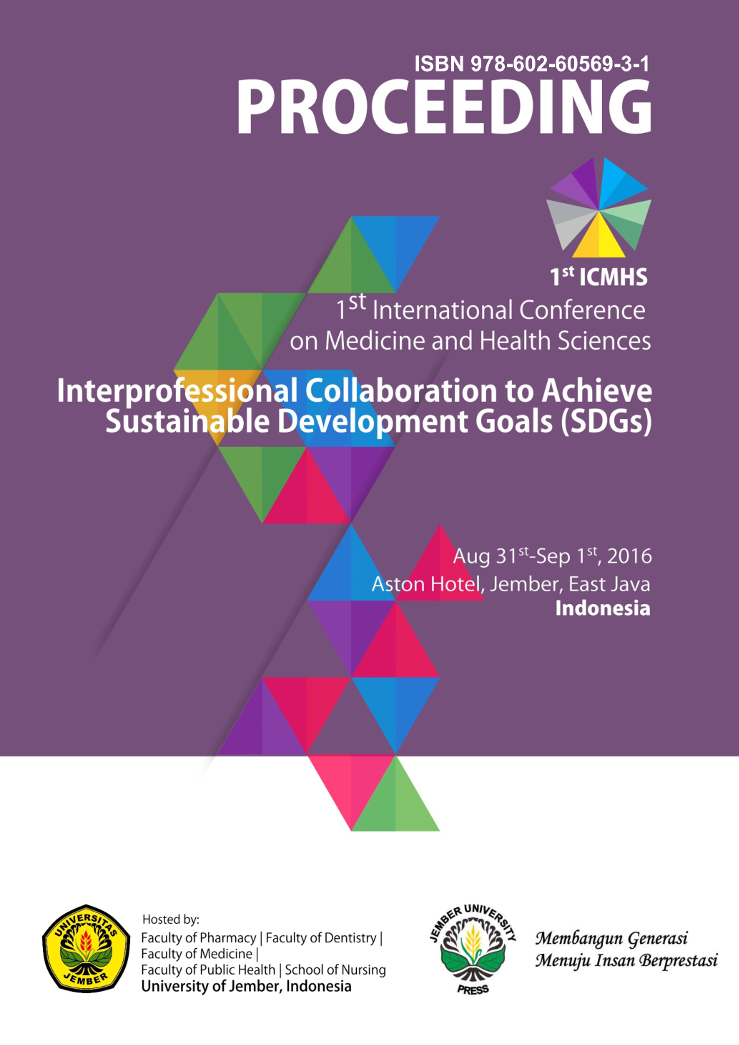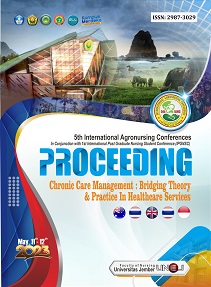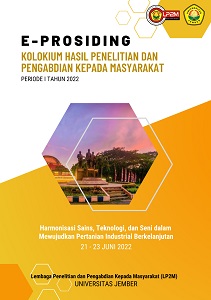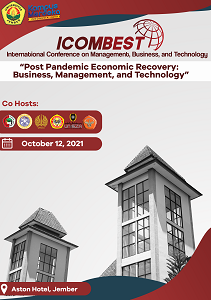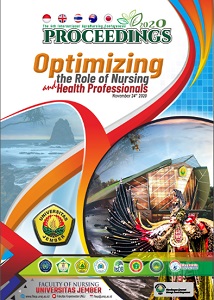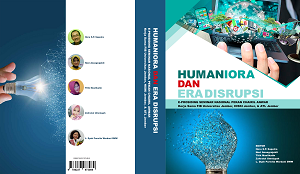THE SOCIAL SUPPORT AND PREVALENCE EMESIS GRAVIDARIUM ON PREGNANT MOTHER IN TRIMESTER I AT PUSKESMAS KEMBARAN I BANYUMAS REGENCY
Abstract
Maternal Mortality Rate (MMR) served as
a basis or benchmark for the country's welfare.
Based on estimation made from the Demographic
and Health Survey Indonesia (IDHS) 1990 to 2007,
it showed that the maternal mortality ratio (MMR)
in Indonesia in 2015 reached 161 / 100,000 live
births, while the MDG targets Indonesia is 102 /
100,000 live births (Health Dept, 2013). The data
from WHO Maternal Mortality Rate (MMR) in
Indonesia in 2013 shows that as many as 8,800 by
the Maternal Mortality Ratio (MMR) of 190 (120-
300) per 100,000 live births (WHO, 2013). The
maternal mortality rate in Central Java Province in
2012 based on reports from regency / city was
116.34 / 100,000 live births, an increase compared
with MMR in 2011 was 116.01 / 100,000 live
births. Most maternal deaths are in Brebes with 51
deaths. Salatiga is the Regency with the least
number of maternal deaths with only 2 cases.
According to the Central Java Provincial Health
Office, there were 32 maternal deaths (Central
Java Health Office, 2012). Additionally, it was
noted that there were maternal mortality by 711
cases and in 2015 there were 115 cases in 2014
(Nurdin, 2015).
The reason of the high death toll in
Indonesia is due to the low quality of life, the
average low education, health status and poor
nutrition, anemia, iron deficiency, and the
incidence of chronic malnutrition (Amaludin,
2015). Pregnant women are in need of adequate
nutrition even doubled because nutrition is needed
by pregnant women to meet the needs not only for
the fetus but also the mother. However,
sometimes pregnant women experience nausea
and excessive vomiting so that nutrition cannot be
fulfilled. Rose & Neil (2006) states that emesis
gravidarium in pregnant women can cause a
variety of negative effects, one of which is a
decrease in appetite that result in changes in the
electrolyte balance of potassium, calcium, and
sodium, causing changes in the body's metabolism.
It affects the fetus, it will be lack of nutrients and
fluids needed by the body, the baby will be born
will be in low birth weight and impaired growth
process. Excessive nausea and vomiting can also
reduce body fluid, so that the blood becomes thick
(hemoconcentration) and blood circulation to
tissues is late. If that happens, then the
consumption of oxygen and nourishment to the
tissues also reduced (Anggarani and Subekti, 2013,
Jeffrey et al, 2003). Lack of oxygen and food to the
network will cause tissue damage that could
reduce maternal health and fetal development in
the womb. In such cases, it needs serious
treatment (Hidayati, 2009).
The purposes of this research are:
1. To find out the characteristics of pregnant
women consisting of age, education level and
occupation.
2. To find out the status of social support for
pregnant women in the first trimester in
Puskesmas Kembaran I Banyumas.
3. To find out the incidence of emesis gravidarium
in the first trimester pregnant women in
Puskesmas Kembaran I Banyumas.
4. To find out the correlation between social
support and emesis gravidarium in the first
trimester of pregnant women in Puskesmas
Kembaran I Banyumas.
a basis or benchmark for the country's welfare.
Based on estimation made from the Demographic
and Health Survey Indonesia (IDHS) 1990 to 2007,
it showed that the maternal mortality ratio (MMR)
in Indonesia in 2015 reached 161 / 100,000 live
births, while the MDG targets Indonesia is 102 /
100,000 live births (Health Dept, 2013). The data
from WHO Maternal Mortality Rate (MMR) in
Indonesia in 2013 shows that as many as 8,800 by
the Maternal Mortality Ratio (MMR) of 190 (120-
300) per 100,000 live births (WHO, 2013). The
maternal mortality rate in Central Java Province in
2012 based on reports from regency / city was
116.34 / 100,000 live births, an increase compared
with MMR in 2011 was 116.01 / 100,000 live
births. Most maternal deaths are in Brebes with 51
deaths. Salatiga is the Regency with the least
number of maternal deaths with only 2 cases.
According to the Central Java Provincial Health
Office, there were 32 maternal deaths (Central
Java Health Office, 2012). Additionally, it was
noted that there were maternal mortality by 711
cases and in 2015 there were 115 cases in 2014
(Nurdin, 2015).
The reason of the high death toll in
Indonesia is due to the low quality of life, the
average low education, health status and poor
nutrition, anemia, iron deficiency, and the
incidence of chronic malnutrition (Amaludin,
2015). Pregnant women are in need of adequate
nutrition even doubled because nutrition is needed
by pregnant women to meet the needs not only for
the fetus but also the mother. However,
sometimes pregnant women experience nausea
and excessive vomiting so that nutrition cannot be
fulfilled. Rose & Neil (2006) states that emesis
gravidarium in pregnant women can cause a
variety of negative effects, one of which is a
decrease in appetite that result in changes in the
electrolyte balance of potassium, calcium, and
sodium, causing changes in the body's metabolism.
It affects the fetus, it will be lack of nutrients and
fluids needed by the body, the baby will be born
will be in low birth weight and impaired growth
process. Excessive nausea and vomiting can also
reduce body fluid, so that the blood becomes thick
(hemoconcentration) and blood circulation to
tissues is late. If that happens, then the
consumption of oxygen and nourishment to the
tissues also reduced (Anggarani and Subekti, 2013,
Jeffrey et al, 2003). Lack of oxygen and food to the
network will cause tissue damage that could
reduce maternal health and fetal development in
the womb. In such cases, it needs serious
treatment (Hidayati, 2009).
The purposes of this research are:
1. To find out the characteristics of pregnant
women consisting of age, education level and
occupation.
2. To find out the status of social support for
pregnant women in the first trimester in
Puskesmas Kembaran I Banyumas.
3. To find out the incidence of emesis gravidarium
in the first trimester pregnant women in
Puskesmas Kembaran I Banyumas.
4. To find out the correlation between social
support and emesis gravidarium in the first
trimester of pregnant women in Puskesmas
Kembaran I Banyumas.
Downloads
Download data is not yet available.
Downloads
Published
2017-01-27
Issue
Section
General

